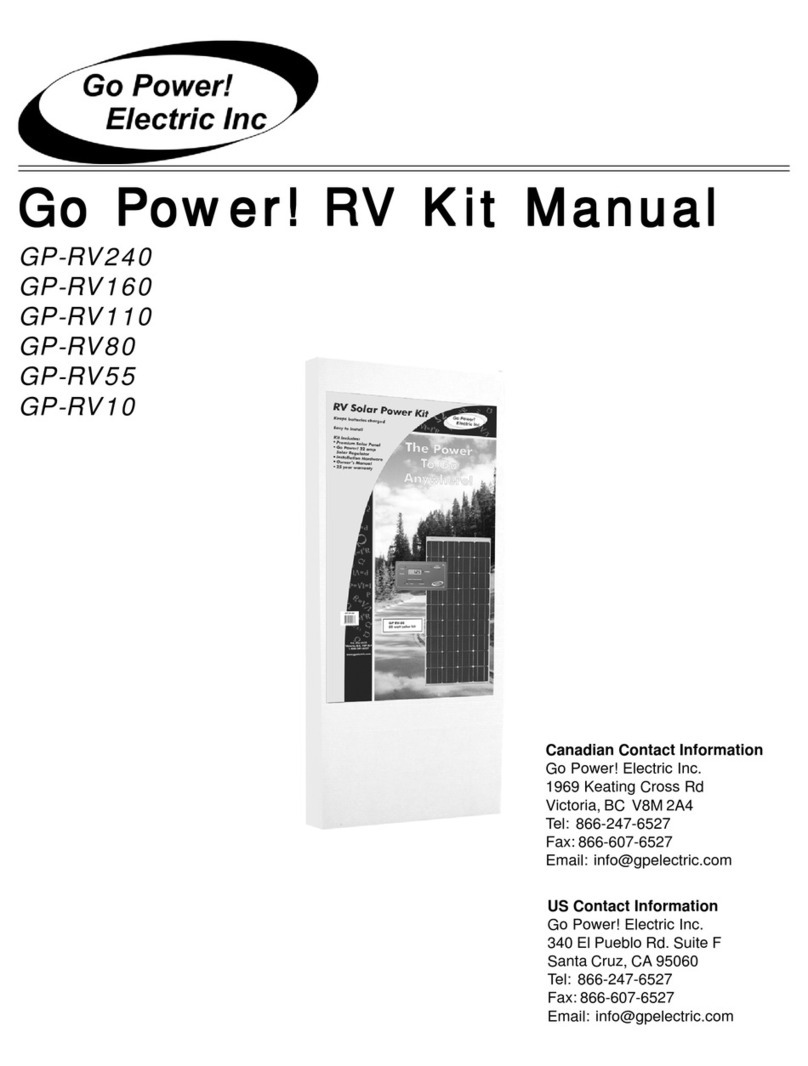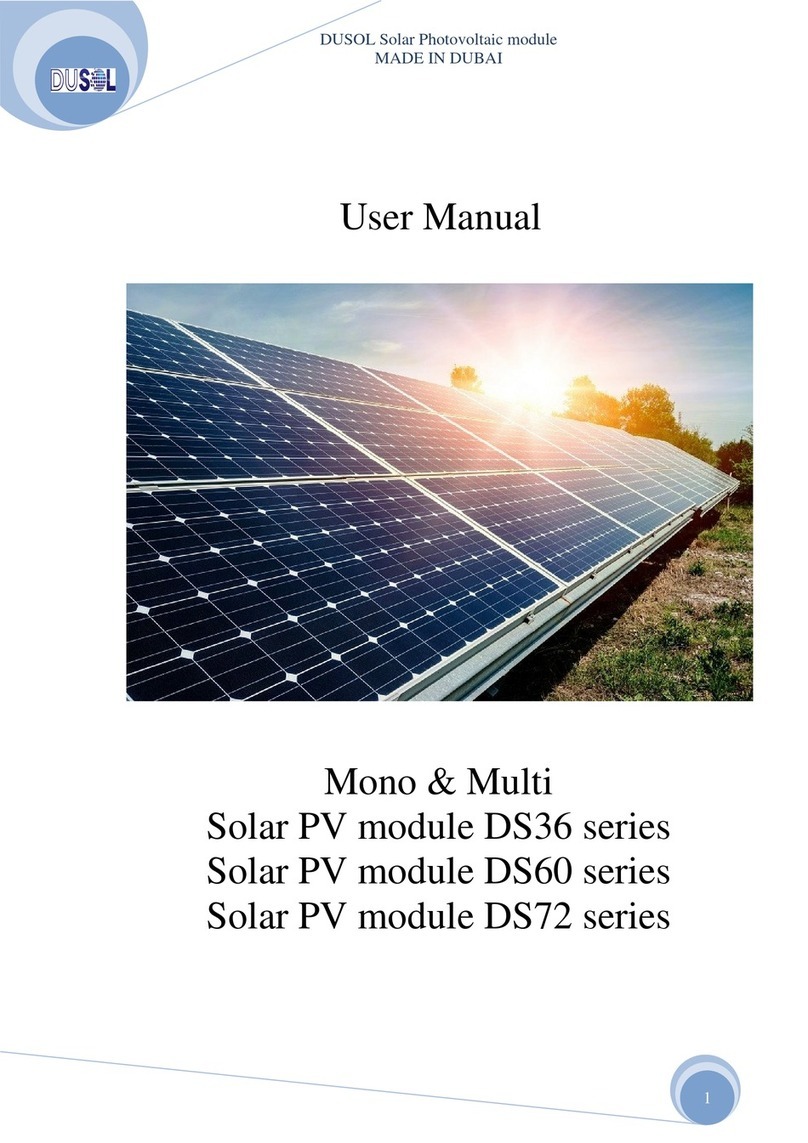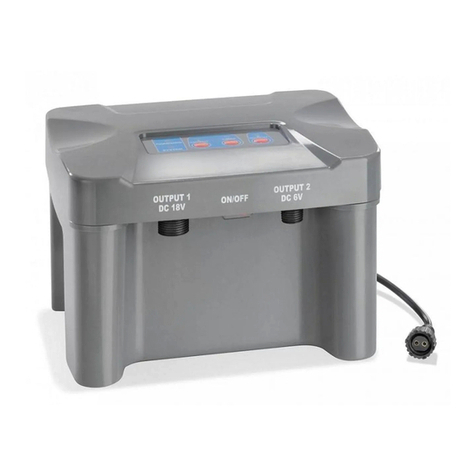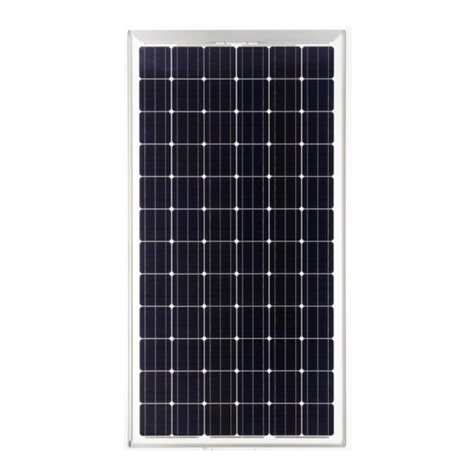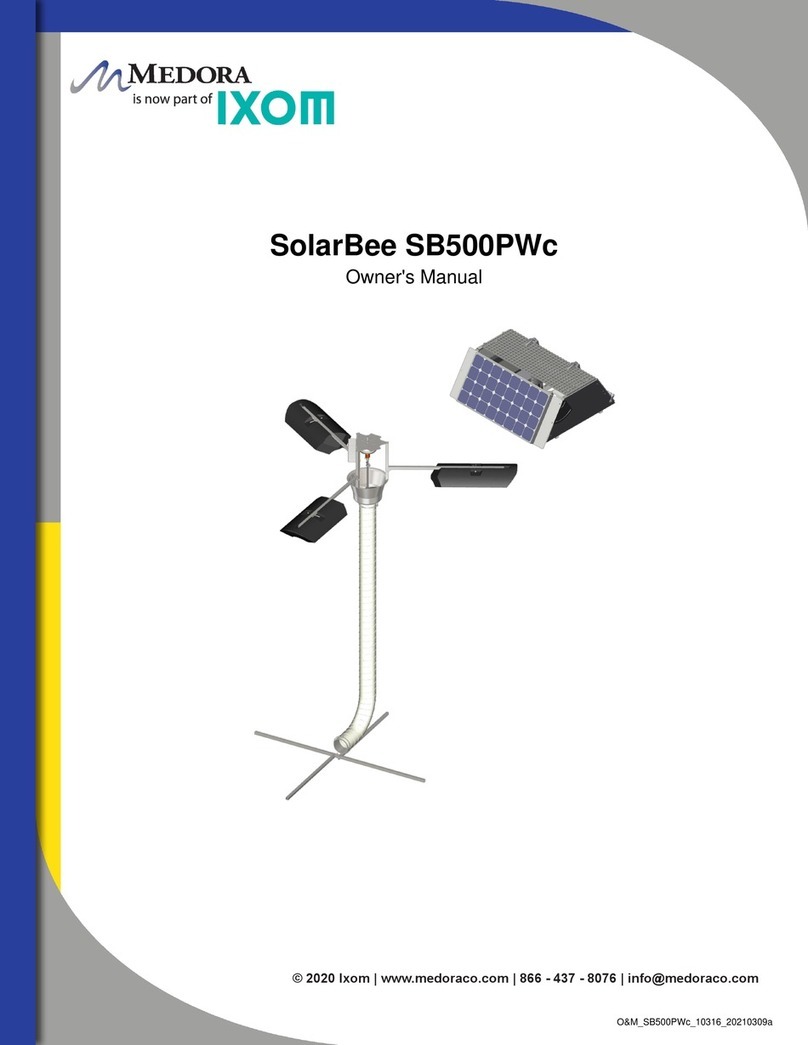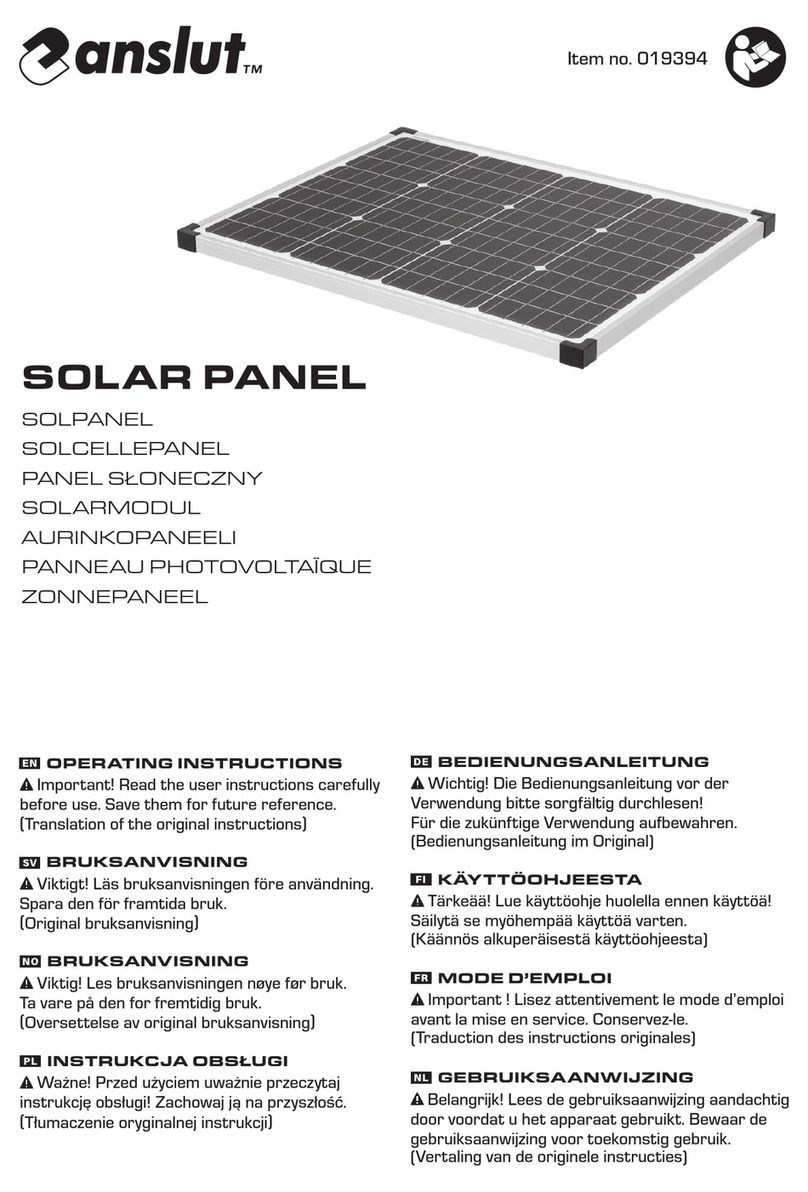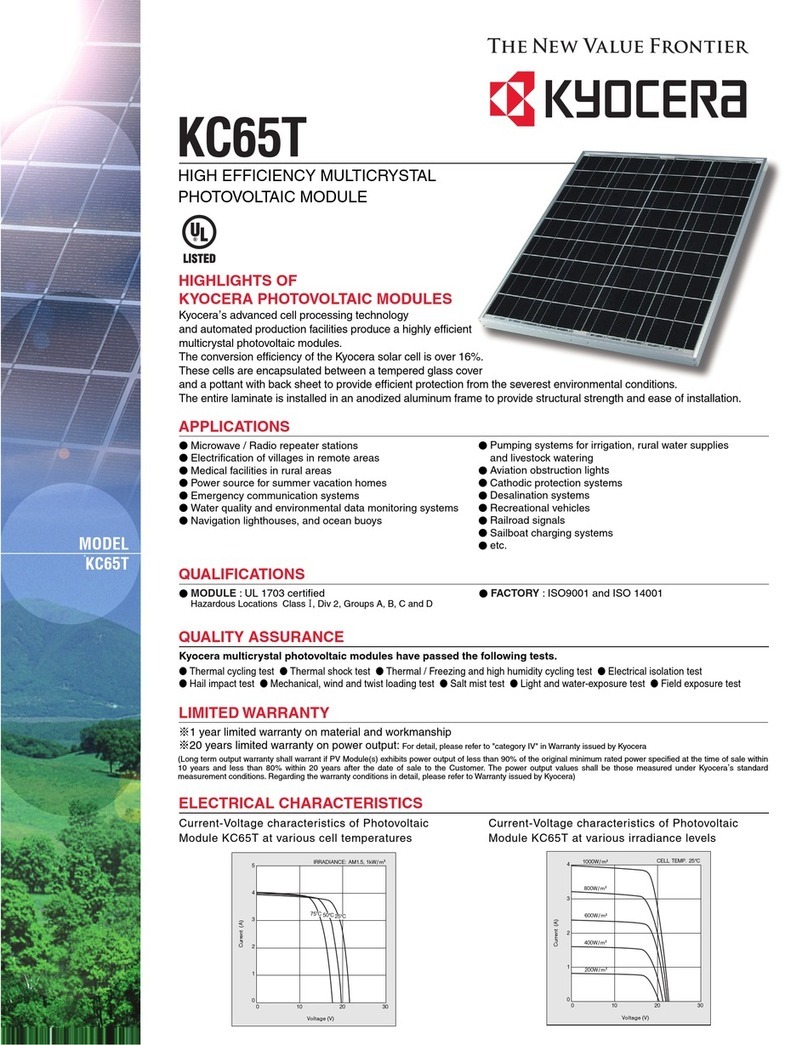Go Power! Electric RV-10 User manual

1
www.gpelectric.com
Go PGo P
Go PGo P
Go Poo
oo
oww
ww
wer! Rer! R
er! Rer! R
er! RV Kit ManV Kit Man
V Kit ManV Kit Man
V Kit Manualual
ualual
ual
GP-RV10
GP-RV50/55/80
GP-RV102/110/115
GP-RV160
GP-RV240
GP-RV50/55E
GP-RV80E
GP-RV102/110E
US Contact Information
Go Power! Electric Inc.
340 El Pueblo Rd. Suite F
Santa Cruz, CA 95060
Tel: 866-247-6527
Fax:866-607-6527
Email: [email protected]
Canadian Contact Information
Go Power! Electric Inc.
1969 Keating Cross Rd
Victoria, BC V8M 2A4
Tel: 866-247-6527
Fax:866-607-6527
Email: [email protected]

2www.gpelectric.com
RV Kit InstallationRV Kit Installation
RV Kit InstallationRV Kit Installation
RV Kit Installation
rev.4.5-08.05GoPower!Electric
RVInstall-2005.p65
Table of Contents
RV Installation Parts and Checklist 3
1.0InstallationOverview 4
1.1 How Does the Go Power! Electric RV Solar Power Kit Work 4
1.2 Warnings 4
1.3 Tools Required (Additional tools may be required) 5
2.0 Wiring the Solar Module and Power Cable 5
2.1 RV-10 5
2.2 RV-55 5
2.3 RV-50/RV-80/RV-160 / Weekender/Snowbird 6
2.4RV-102/RV-110/RV-115/RV-204/RV-220 6
2.5 Expander Kits - Using an Interconnect Cable 6
3.0 Wiring the RV-102/RV-110/RV-115 Kits 7
3.1 Wiring Two Solar Modules In Parallel with MC Cables 7
3.2 Modules with MC Connectors Wired to a Non-Potted Junction Box 7
4.0 Routing Power Cable through the Fridge Vent 7
4.1 Method 1 – Hole in Side of Vent 7
4.2 Method 2 – Through Screen Grid 7
5.0MountingtheSolarModule 7
5.1Using the Mounting Feet 8
6.0 Installing the GPR-22 Regulator 8
6.1MountingtheRegulator 8
7.0 Connecting to the Battery & SolarArray 9
7.1 Typical Battery Connection 9
8.0 Limited Warranty 9
8.1 General Warranty Issues 9
8.2 Repair and Return Information 10
9.0 System Glossary 11

3
www.gpelectric.com
Standard Kits
Snowbird BP75MONO Freedom Independence
PART
01. Ring Terminal Battery Connector
02. Power Cable (7 m)
03. Tie Wrap
04. Interconnect cable
05. Positive MC Parallel Cable
06. Negative MC Parallel Cable
07. Connector & lock nut
08. #10/32 Well Nut
09. #10/32 Well Nut Bolt
10. #10/32 Well Nut Flat Washer
11. #10/32 Well Nut Lock Washer
12. #6 Self-tapping screws
13. Cable clamp
14. ¼” Bolt
15. ¼” Flat Washer
16. ¼” Lock Washer
17. ¼” Nut
18. Mounting Feet
19. Solar module
20. GPR-22 Amp Regulator
21. ARM-UNI Mount (Optional)
Note: You may not need all included parts for your particular installation
Kits with MC connectors will not include parts 04 and 07.
Only kits with MC connectors and more than one module will include parts 05 and 06.
RV Kit InstallationRV Kit Installation
RV Kit InstallationRV Kit Installation
RV Kit Installation
01
02
03
04
07
09
10
11
12
13
14
15
16
18
19 Solar Module
GPR-22 A
Regulator
20
Parts Checklist
Battery
(not included)
17
08
(Optional)
21
05
06
2
1
6
-
-
-
1
4
4
4
4
6
6
4
4
4
4
4
1
1
2
1
6
2
-
-
1
12
12
12
12
6
6
12
12
12
12
12
3
1
2
1
6
-
-
-
-
6
6
6
6
6
6
6
6
6
6
6
1
1
2
1
6
1
-
-
1
8
8
8
8
6
6
8
8
8
8
8
2
1
-
-
-
1
-
-
-
4
4
4
4
-
-
4
4
4
4
4
1
-
-
-
-
-
1
1
-
6
6
6
6
-
-
6
6
6
6
6
1
-
2
1
6
-
-
-
1
4
4
4
4
6
6
4
4
4
4
4
1
1
-
-
-
1
-
-
-
4
4
4
4
-
-
4
4
4
4
4
1
-
2
1
-
-
-
-
1
4
4
4
4
6
6
4
4
4
4
4
1
-
RV-10 RV-50/
55 RV-80 RV-102/
110/115 RV-160 RV-240 RV-50/
55E RV-80E RV-102/
110/115E

4www.gpelectric.com
RV Kit InstallationRV Kit Installation
RV Kit InstallationRV Kit Installation
RV Kit Installation
1.0 Installation Overview
Congratulations on your purchase of a Go Power! Electric RV Solar Power Kit. You have
chosen a clean, quiet and sustainable way to provide power to your recreational vehicle.
A Go Power! Electric RV Solar Power Kit gives you the ability to dry camp while ensuring
your batteries remain fully charged. The Go Power! Electric RV Solar Power Kit allows
you to enjoy the luxuries and necessities that electricity provides, with or without a
campsite hookup. For simple battery maintenance to full-time live-aboard power, Go
Power! Electric RV Solar Power Kits are available in a variety of sizes and can be
installed on RVs, campers, trailers, 5th wheels and motor homes.
1.1 How Does the Go Power! Electric RV Solar Power Kit Work
The solar module converts a portion of the sun’s energy into DC electricity and this
electricity or specifically the current travels to the battery via a conductor, usually
copper wire. The battery stores the current as amperage, similar to a water tank
storing water. A battery is also designed to produce voltage which, when combined
with amperage, gives power. The battery power may be used at any time to operate
devices connected to the battery. When a battery is receiving and storing current from
the solar module, the battery is referred to as being charged or charging. To stop the
battery from being overcharged by the solar module, a charge controller or regulator
is connected between the two. The GPR-22 regulator will disconnect power from the
solar module when the battery voltage reaches the fully charged point. A battery can
only absorb a small percentage of its capacity at any given time, therefore when the
regulator stops the charging process the battery voltage will drop slightly. Once the
battery voltage drops by approximately one volt, the GPR-22 regulator will resume
charging.
Please read and understand all instructions before installing your new product for the
easiest and safest installation. Before installing the kit, please review the installation
design included in this Installation Manual. If you have any doubts as to this kit’s
sustainability or compatibility with your RV, please contact your authorized Go Power!
Electric RV Dealer. It is advisable to retain this manual for future reference.
1.2 Warnings
Electrical Safety
Disconnect all power sources before attempting installation. Electricity can be very
dangerous. Installation should be performed only by a licensed electrician or qualified
personnel.
Solar Module Safety
Photovoltaic modules generate DC electricity when exposed to sunlight or other light
sources. Contact with the electrically active parts of the module, such as terminals, can
result in burns, sparks and lethal shock whether the module is connected or disconnected.
When modules are connected in parallel, amperages are additive. Consequently, a
system assembled from photovoltaic modules can produce high amperages, which
constitute an increased hazard.
Do not touch terminals while module is exposed to light. Cover the module face
completely with opaque material to halt the production of electricity when installing or
working with modules or wiring.
Battery Safety
Observe all safety precautions of the battery manufacturer when handling or working
around batteries. When charging, batteries may produce explosive hydrogen gas. Work
in a well ventilated area and use caution when making or removing electrical connections.
Ensure wires are disconnected from their power sources when wiring. Do not expose
battery to open flame, cigarettes, or sparks. Shield skin and eyes from battery acid.
Wiring Safety Ensure all connections are tight and secure. Loose connections may
generate sparks.
Work safely Wear protective eyewear and appropriate clothing during installation.
Use extreme caution when working with electricity and when handling and working
around batteries. Use properly insulated tools only.

5
www.gpelectric.com
RV Kit InstallationRV Kit Installation
RV Kit InstallationRV Kit Installation
RV Kit Installation
Note:
This installation guide does not list
all possible variations of available
solar modules. This installation guide
will address the assembly of
standard Go Power! Electric RV Solar
Power Kits, which contain one, two or
three solar modules connected in
parallel for a 12 volt system.
Expander Kits are available to add
solar modules to an existing system.
Observe correct polarity at all times. Any contact in reverse polarity, however
brief, will cause the regulator and/or inverter fuse to blow and may damage the unit.
Do not exceed the voltage and current ratings of the regulator. The total
current of the solar system is the sum of the short circuit current of the solar modules
in parallel multiplied by a safety factor of 1.25. The resulting system current is not to
exceed the amperage rating of the regulator. The voltage of the array is the rated open
circuit voltage of the solar modules and is not to exceed 26 volts for a 12 volt system
and 52 volts for a 24 volt system. If your solar system exceeds these ratings, contact
your dealer for a suitable regulator alternative.
1.3 Tools Required (Additional tools may be required)
a. Slot Screwdriver
b. # 2 Robertson Square Head Screwdriver
c. Keyhole saw
d. Punch or Awl
e. Pliers
f. Wire Strippers
2.0 Wiring the Solar Module and Power Cable
Please follow the directions in the appropriate section, depending on which kit you are
about to install.
Kit Model Manual Section
RV-10 Section 2.1
RV-50/55 Section 2.2
RV-80 Section 2.3
RV-102/110/115 Section 2.3
Weekender Section 2.3
RV-160 Section 2.4
RV-240 Section 2.4
Snowbird Section 2.4
Wiring Diagrams (located at the end of the manual)
Junction Boxes Diagram-1
Wiring Single and Parallel Modules Diagram-2
Cable Extensions for MC Connectors Diagram-3
MC Connections for 1-2 Modules Diagram-4
2.1 RV-10
1. Remove the module’s Junction Box cover. Remove the knockout on the Junction
Box for the connector and power cable. In some cases the connector may have
already been factory installed. To remove the knockout on the Junction Box, hold a
screwdriver tip against the knockout and strike sharply.
2. Install the connector for the power cable as shown in Diagram-1, “Junction Boxes”.
Strip back 3” of sheathing from the power cable. Insert the stripped back end of the
power cable through the connector and into the junction box. Secure the black wire
under the screw on the positive terminal, and the white wire under the negative
terminal. If the power cable consists of red and black wire, then red is positive and
black is negative. Ensure that all the wiring connections are tight. Replace the Junction
Box cover.
3. Continue to Section 4, “Routing the Power Cable through the Fridge Vent”.
The RV-10 solar module has a limited 5 year warranty.
2.2 RV-55
1. Remove the module’s Junction Box cover. Remove the knockout on the Junction
Box for the connector and power cable. In some cases the connector may have
already been factory installed or may consist of a foam insert. To remove the
knockout on the Junction Box, hold a screwdriver tip against the knockout and
strike sharply.
g. Wire crimpers
h. Electric hand drill
i. 1/16 and 3/8 inch drill bit
j. 5/16 and 7/16 inch wrench
k. Sealant

6www.gpelectric.com
RV Kit InstallationRV Kit Installation
RV Kit InstallationRV Kit Installation
RV Kit Installation
The RV-55 module may have two junction boxes, one for the positive (+) wire and
one for the negative (-) wire. In this case, strip back enough sheathing from the
power cable to insert a single wire into each junction box.
2. Install the connector for the power cable as shown in Diagram-1, “Junction Boxes”.
Strip back 3” of sheathing from the power cable.
3. Insert the stripped back end of the power cable through the connector and into the
junction box. Secure the red wire under the screw on the positive terminal, and the
black wire under the negative terminal. Ensure that all the wiring connections are
tight. Replace the Junction Box covers.
4. Continue to Section 4, “Routing the Power Cable through the Fridge Vent”.
2.3 RV-50/80/ Weekender – Single Panel/Wiring One Junction Box
1. Strip 6” of outer sheathing from the power cable exposing the positive (red) and
negative (black) wires. Do not “nick” wires.
2. Refer to Diagram-1, “Junction Boxes” and Diagram-2, “Wiring Single and Parallel
Modules”. Remove the module’s Junction Box cover. Remove the knockout on the
Junction Box for the power cable. To remove the knockout on the Junction Box, hold
a screwdriver tip against the knockout and strike sharply.
3. Install the ½” connector for the power cable onto the Junction Box. Secure the red
wire under the positive terminal, and the black wire under the negative terminal.
Ensure that all wiring connections are tight. Replace the Junction Box cover.
4. Continue to Section 4, “Routing the Power Cable through the Fridge Vent”.
2.4 RV-160/RV-240/Snowbird/Expander Kits - Multipanel - Using an
Interconnect Cable
1. Strip 6” of outer sheathing from the power cable, exposing positive (red) and negative
(black) wires. Do not “nick” wires.
2. Remove the modules’ Junction Box covers. Place the modules side-by-side, glass
down. Remove the knockout on the Junction Box for the cable. To remove the
knockout on the Junction Box, hold a screwdriver tip against the knockout and
strike sharply.
3. Refer to Diagram-1, “Junction Boxes” and Diagram-2, “Wiring Single and Parallel
Modules”. Install the connector for the power cable onto the Junction Box. Secure
the red wire under the screw for the positive terminal, and the black wire under the
negative terminal. Ensure that all the wiring connections are tight.
4. Install the interconnect cable between the modules as shown in Diagram-2, “Wiring
Single and Parallel Modules”. Make sure the red wires are secured under the positive
terminals, and the black wires are secured under the negative terminals. Ensure
that all wiring connections are tight. Replace the Junction Box covers.
5. Continue to Section 4, “Routing the Power Cable through the Fridge Vent”.
2.5 Expander Kits - Junction Box - Using an Interconnect Cable
1. Strip 6” of outer sheathing from the power cable, exposing positive (red) and negative
(black) wires. Do not “nick” wires. Remove the modules’ Junction Box covers. Place
the modules side-by-side, glass down.
2. Remove the knockout on the Junction Box for the power cable. To remove the
knockout on the Junction Box, hold a screwdriver tip against the knockout and
strike sharply.
3. Refer to Diagram-1, “Junction Boxes” and Diagram-2, “Wiring Single and Parallel
Modules”.
Note:
For modules with MC cables and a
sealed junction box, refer to
Diagram-3, “MC Connections for 1-2
Modules” and Section 3.

7
www.gpelectric.com
RV Kit InstallationRV Kit Installation
RV Kit InstallationRV Kit Installation
RV Kit Installation
Caution:
The screen may have sharp edges or
burrs.
Figure 1
Vent
Screen
Refrigerator
Vent Cover Solar
Module
Cable
Clamps
Method
2
Method
1
4. Install the connector for the power cable in the Junction Box. Secure the red wire
under the screw for the positive terminal, and the black wire under the negative
terminal. Ensure that all the wiring connections are tight. Install the interconnect
cable between the modules as shown in the wiring diagrams. Make sure the red
wires are secured under the positive terminals, and the black wires are secured
under the negative terminals. Ensure that all wiring connections are tight. Replace
the Junction Box covers.
5. Expander Kits for modules with two junction boxes will have a single red wire
connecting the two positive junction boxes together and a single black wire connecting
the two negative junction boxes together. The Power Cable will then be connected
to the positive and negative junction box of one of the modules.
6. Continue to Section 4, “Routing the Power Cable through the Fridge Vent”.
3.0 Wiring the RV-102/110/115 Kits
RV Kits containing a single module with MC cables will be equipped with an MC power
cable. Plug in the appropriate connections. Refer to Diagram-3, “MC Connections for
1-2 Modules”.
3.1 Wiring Two Solar Modules In Parallel with MC Cables
RV Kits containing two modules with MC cables will be equipped with an MC power
cable, a negative MC parallel cable, and a positive MC parallel cable. Plug in the
appropriate connections. Refer to Diagram-3, “MC Connections for 1-2 Modules”.
3.2 Modules with MC Connectors Wired to a Non-Potted Junction Box
Please be aware that some modules are equipped with MC cables and a fully functioning
non-potted Junction Box. In this case, the MC cables may be ignored and the Junction
box may be wired normally. The MC cables may be removed or left in place as long as
they do not impede the installation process. Do not connect the positive and negative
MC cables from the same junction box together; this will short circuit the module.
4.0 Routing Power Cable through the Fridge Vent
Locate the refrigerator vent on the roof of the RV. Remove vent cover to gain access to
the duct opening. Refer to Figure 1. Retain vent-fastening hardware.
4.1 Method 1 – Hole in Side of Vent
Drill a hole through the side of the vent (5/8” hole). Insert a rubber grommet (not
included) into the hole. Insert the power cable (already wired to the solar module)
through the hole and carefully route it to the battery. Be certain to leave enough slack
to allow cable routing from module to vent along desired path.
4.2 Method 2 – Through Screen Grid
1. Thread power cable (already wired to solar module) carefully through the screen
and into opening. Enlarge screen grid hole if necessary.
2. Avoid strapping the power cable to existing wire between the module and the battery.
Allowing a few inches of space between the power cable and existing wire will
lessen the chance of voltage loss through thermal conduction. Use cable clamps
with the # 6 self-tapping screw and/or tie wraps every few feet along RV roof and
interior route to battery.
3. Ensure all penetrations into the RV roof are watertight. Use an appropriate sealant
as recommended by your RV Dealer to seal holes wherever necessary.
4. Replace vent cover.
5.0 Mounting the Solar Module
Cover the entire module with paper to prevent the danger of shock during installation.
Do not remove the paper until the installation is complete. The solar modules may be
horizontally mounted to the roof using the included mounting feet. An optional adjustable
roof mount (ARM-UNI) is also available from Go Power! Electric Inc.
Caution:
On contact, uncured adhesive/
sealant may irritate eyes. In the
event of contact, flush eyes with
water and consult a physician
immediately.

8www.gpelectric.com
RV Kit InstallationRV Kit Installation
RV Kit InstallationRV Kit Installation
RV Kit Installation
5.1 Using the Mounting Feet
1. Assemble the mounting feet onto the ends of the solar module using the 1/4” bolts,
washers and nuts as shown in Figure 2.
2. Tighten nuts securely using a 7/16” wrench.
3. Place the module in a location that follows the criteria listed here:
• Select a location where the mounting surface is at least 1/2" thick and strong
enough to support mounting hardware, the solar module and wind loads.
• Minimize distance between the location of the solar module and the location
where the power cable will enter the vehicle to connect to the battery.
• Place the module lengthwise along the roof to reduce wind loading on vehicles
(if applicable).
• Avoid internal wiring when selecting the spots for drilling the four mounting
holes.
• Ensure obstacles, such as air conditioners, will not shade the solar module.
* Place module so that you have room to expand the current system if needed.
4. Mark the mounting hole locations by using a pencil to trace through the holes in the
mounting feet. Drill mounting holes only one inch deep with a 3/8” drill bit.
5. Use the appropriate sealant as recommended by your RV Dealer to ensure a
watertight installation.
6. Gently insert the well-nuts into the drill holes so that only the topmost flange part
remains above the roofline. Be careful not to push well-nuts through the holes.
7. Insert screws with lock washers and tighten. Do not overtighten.
6.0 Installing the GPR-22 Regulator
The GPR-22 regulator is included in all Go Power! RV Kits except the GP-RV10
and Expander Kits.
The GPR-22 regulator provides the necessary protection for the RV battery system. A
condensed version of the installation instructions appear below, however please read
the full installation manual included with the GPR-22 regulator.
1. Disconnect or cover the solar modules and disconnect the batteries before
commencing the GPR-22 regulator wiring.
2. Run the solar module power cable to the location of the GPR-22 regulator. Do not
connect the wires to the regulator or the batteries. Identify the polarity
of the wires located on the battery and solar module (positive and
negative). Use coloured wires or mark wire ends with tags. Contacting the leads
of the regulator in reverse polarity, however brief, will blow the panel fuse and may
damage the GPR-22.
3. Wire the regulator according to the wiring schematic shown in Figure 4 and Figure
5. Tighten all connections.
4. Read the GPR-22 regulator Manual prior to installing.
6.1 Mounting the Regulator
The GPR-22 regulator should be mounted in a location relatively close to the battery,
but easily seen for monitoring system operation. Wires must be run from the solar
module to the regulator and then to the battery. The GPR-22 regulator is designed to be
flush mounted on the side of a cabinet or wall where the wiring can be accessed from
the back. Allow two to three inches behind the unit. The regulator should be mounted
indoors, in a dry location.
1. Select a suitable location for the installation of the regulator. Run the power cable
from the solar module to the location selected.
Figure 4 GPR-22 regulator
wiring schematic
Figure 5
GPR-22 regulator
wiring connection detail
Figure 3
Solar
Module
1/4” Flat
Washer
1/4’
Lock
Washer
1/4’ Bracket
Bolt
Mounting
Foot
RV
Roof
Figure 2
1/4” Nut
RV
Roof
Solar
Module
Mounting
Foot
Load
Battery
Solar Array

9
www.gpelectric.com
RV Kit InstallationRV Kit Installation
RV Kit InstallationRV Kit Installation
RV Kit Installation
2. Use the template included in the GPR-22 Regulator Manual to mark the four mounting
holes and the “cutting line for flush mounting”. Drill the mounting holes. Use a
keyhole or jig saw to cut along the rectangular outline you marked.
3. Wire the regulator as shown in the GPR-22 Regulator Manual. Use the leftover
power cable to connect the regulator to the batteries.
4. Mount the regulator to the wall using the four wood screws provided. Slip the washers
(supplied) over the screws so the washers are between the back of the regulator
and the wall. This provides an air gap for added cooling. Ensure the back of the
regulator is protected from damage by any object.
7.0 Connecting to the Battery & Solar Array
It is recommended to connect directly to the battery wherever possible.
1. Clean all corrosion from battery terminals before proceeding. Crimp ring terminals
onto the negative and positive wires of the power cable to be attached to the battery.
2. Attach the negative (black) wire’s 3/8” ring terminal to the RV battery. Check all
electrical connections and apply a protective coating to battery terminals.
7.1 Typical Battery Connection
1. Multiple 12 volt battery connection. (See Figure 6)
2. 6 volt battery connection. (See Figure 7)
8.0 Limited Warranty
1. Go Power! Electric Inc. warrants the Go Power! Electric RV Solar Power Kit for a
period of one (1) year from the date of shipment from its factory. This warranty is
valid against defects in materials and workmanship for the one (1) year warranty
period. It is not valid against defects resulting from, but not limited to:
• Misuse and/or abuse, neglect, or accident.
• Exceeding the unit’s design limits.
• Improper installation, including, but not limited to, improper environmental
protection and improper hook-up.
• Acts of God, including lightning, floods, earthquakes, fire, and high winds.
• Damage in handling, including damage encountered during shipment.
2. This warranty shall be considered void if the warranted product is in any way opened
or altered. The warranty will be void if any eyelet, rivets, or other fasteners used to
seal the unit are removed or altered, or if the unit’s serial number is in any way
removed, altered, replaced, defaced or rendered illegible.
3. The one (1) year term of this warranty does not apply to equipment where another
manufacturer’s warranty is available. This may include but is not limited to, the
charge controller, the solar modules and the inverter. The time limit for this warranty
may be for more or less than the Go Power Electric Inc. limited warranty. Go Power
Electric Inc. will assist the claimant in attempts to seek warranty claims for such
equipment.
8.1 General Warranty Issues
Refer to the manufacturer’s warranty sheet(s) where applicable.
1. Go Power Electric Inc. cannot assume responsibility for any damages to any system
components used in conjunction with Go Power Electric Inc. products, nor for claims
for personal injury or property damage resulting from the use of Go Power Electric
Inc. products or the improper operation thereof or consequential damages arising
from the products or use of the products.
2. Go Power Electric Inc. cannot guarantee compatibility of its products with other
components used in conjunction with Go Power Electric Inc. products, including, but
not limited to, solar modules, batteries, and system interconnects, and such loads
as inverters, transmitters, and other loads which produce “noise” or electromagnetic
interference, in excess of the levels to which Go Power Electric Inc. products are
compatible.
12 V Batteries
Figure 6
Red (Positive Wire)
Figure 7
6 V Batteries
Solar
Regulator
Black
(negative)
wire
Solar
Regulator

10 www.gpelectric.com
3. Warranty repair and/or evaluation will be provided only at the Victoria, British
Columbia facility of Go Power Electric Inc. Units for such repair and/or evaluation
must be returned freight prepaid to Go Power Electric Inc. with a written description
of any apparent defects. An RMA # issued only by Go Power Electric Inc. must be
clearly visible on the outside of the returned package. Go Power Electric Inc. will
not be required at any time to visit the installation site wherein Go Power Electric
Inc. products are subject to warranty repair and/or evaluation.
4. Only Go Power Electric Inc. is authorized to repair any of its products, and they
reserve the right to repair or replace any unit returned for warranty repair. The
party returning a unit for repair is responsible for proper packaging and for shipping
and insurance charges, as well as any other charges encountered, in shipping to
and from Go Power Electric Inc.
5. The purchaser’s exclusive remedy for any and all losses or damages resulting from
the date of sale of this product including, but not limited to, any allegations of
breach of warranty, breach of contract, negligence or strict liability, shall be limited,
at the option of Go Power Electric Inc., to either the return of the purchase price or
the replacement of the particular product for which claim is made and proved. In
no event shall Go Power Electric Inc. be liable to purchaser or purchaser’s customers
or to anyone else for any punitive, special, consequential, incidental or indirect
losses or damages resulting from the sale of the product, whether based upon loss
of goodwill, lost profits, work stoppages, impairments of other goods, breach of
contract, or otherwise.
6. This warranty supersedes all other warranties and may only be modified by statement
in writing, signed by Go Power Electric Inc.
7. Warranty terms effective as of January 2, 2004.
8.2 Repair and Return Information
To return items:
1. Call your Go Power Electric Inc. sales representative or Go Power Electric Inc.
Technical Support (1-866-247-6527) to try and troubleshoot the problem.
2. Obtain an RMA # through your Go Power Electric Inc. sales representative or Go
Power Electric Inc. Technical Support.
3. Ensure the RMA # is clearly visible on the outside of the package, or THE PACKAGE
WILL BE REFUSED.
4. Ship to Go Power Electric Inc. PREPAID at the following address:
CANADA
Go Power Electric Inc.
1969 Keating Cross Rd.
Victoria, BC V8M 2A4
5. Do not ship product collect, unless approved by management prior to Go Power
Electric Inc. receiving said product, or THE PACKAGE WILL BE REFUSED.
6. Test items or items that are not under warranty, or units that are not defective, will
be charged a minimum bench charge of $50.00 US plus taxes and shipping.
7. A 15% restocking charge will be applied on goods returned and accepted as “new”
stock.
USA
Go Power Electric Inc.
340 El Pueblo Rd. Suite F
Santa Cruz, CA 95060
RV Kit InstallationRV Kit Installation
RV Kit InstallationRV Kit Installation
RV Kit Installation

11
www.gpelectric.com
9.0 System Glossary
Ampere A unit of electrical current. Designates the number of electrons flowing per
second through a conductive material.
Ampere-Hour (Ahr or amp hour): A unit of energy, typically referring to battery
capacity. One ampere of current flowing for one hour.
Azimuth of the Sun: The angular measure between due south and the point on the
horizon directly below the sun.
Array: A number of photovoltaic modules electrically connected to produce a single
electrical output.
Angle of Incidence: The angle between a ray of sunlight striking a surface and a line
perpendicular to that surface. Rays perpendicular to a surface have a zero angle of
incidence.
Battery: Two or more electrochemical cells connected to provide energy storage.
May be used to designate one cell. PV system batteries may be “sealed” or “flooded”.
Blocking Diode: A diode application that prevents a battery from discharging through
the array at night or if the array becomes shaded. Most charge controllers are equipped
with a blocking diode.
Charge Controller (regulator): The PV system component that controls the battery’s
state of charge. It may also provide other system control functions. Also known as a
regulator.
Charge Rate: The current applied to a battery to restore its energy capacity. The
battery manufacturer will usually have a recommended charge rate for their product.
The rate is typically 10 –20 percent of the amp hour capacity at the 20-hour rate.
Current: DC or Direct Current is the type of electron flow provided by a battery or
solar cell, which flows in one direction. The unit for current is ampere or amp for short
and designated by the letter A.
Cycle: One battery cycle equals one discharge and one charge.
Deep Cycle Battery: Batteries that are designed to discharge as much as 80% of
their capacity as opposed to engine-starting or shallow cycle batteries which are designed
for heavy cranking but will not stand up to repeated deep discharges.
Depth of Discharge: A measure of how much energy has been withdrawn from a
battery, expressed as a percentage of full capacity. A 100 Ahr battery from which 30
Ahr has been withdrawn has undergone a 30% depth of discharge (DOD). This term is
the inverse of state of charge (SOC); the example battery would be at 70% SOC.
Diode: A semi-conductor device that allows current to flow in one direction only.
“Blocking diodes” and “isolation diodes” are standard diodes that have specific
applications.
Electrolyte: Battery acid.
Equalization: The process that equalizes the specific gravity of all the cells in a
battery by means of a controlled overcharge that breaks down sulfation on the battery
plates. Most inverter/chargers and some charge controllers are equipped with this
feature. Usually performed only on flooded batteries.
Flooded or Wet Cell Batteries: The most common type of PV battery. Battery caps
may be removed to expose the electrolyte inside the battery. Need proper ventilation
due to gassing and may need to be topped up with distilled water at regular intervals.
Grid-Connected: A power system interconnected with the grid (or mains) of the local
electric utility. Also referred to as utility-interactive or grid-tie.
RV Kit InstallationRV Kit Installation
RV Kit InstallationRV Kit Installation
RV Kit Installation

12 www.gpelectric.com
Hybrid System: A power system consisting of two or more energy sources (e.g., a
PV array and a wind generator).
Hydrometer: A device used to measure the specific gravity (SG) of the electrolyte in
a flooded battery. A very accurate way to see the true charge of a battery.
Insolation: The solar energy received at a place over a given period. May be expressed
as sunhours per day, watts per square meter per hour, or any number of other units.
Inverter: A device that converts DC electricity to AC.
Isolation Diode: A diode application that prevents one segment of an array from
interacting with another array segment. Usually used in situations where two parts of
an array are facing in different directions therefore one part of an array may experience
shading while the other does not. Prevents array energy from flowing backwards through
a low voltage string of the array. May also serve the function of blocking diode.
Maximum Power (peak power): The point of a solar array, panel or module output
where the product of Imp and Vmp (Pmax, measured in watts) is maximized. The
points used to calculate Pmax are Imp (current @ max power) and Vmp (voltage @
max power).
Module: A number of solar cells electrically connected, and protected from the
environment usually by an aluminum frame covered with a pane of glass. A module is
self-contained and not sub dividable, therefore providing a single electrical output.
NOCT (Nominal Operating Cell Temperature): the temperature at which PV cells
in a module operate under Standard Operating Conditions (SOC), which are: irradiance
of 0.8 kW/m2, 20ºC ambient temperature, and average wind speed of 1 m/s, with the
wind oriented parallel to the plane of the array, and all sides of the array fully exposed
to the wind.
Open-Circuit Voltage (Voc):Refers to a photovoltaic device’s voltage potential when
it is disconnected from the rest of the PV system.
Panel: A group of photovoltaic modules (or single module) mechanically mounted on
a single frame.
Parallel Connection: Electrical connection where the positive terminals of a number
of devices are connected together, as are their negative terminals. The output voltage
is usually limited to the device with the lowest voltage, and the total current is the sum
of the current of all the devices.
Photovoltaic (PV):Capable of producing a voltage when exposed to radiant energy,
especially light.
Regulator: See “Charge Controller” definition.
Sealed Batteries: Electrolyte will not spill out and gassing is kept to a minimum. A
sealed battery is maintenance free and may be installed in several orientations.
Series Connection Electrical connection where the positive terminal of one device is
attached to the negative terminal of the next in a series string; in this connection, the
string voltage is the sum of the device voltages and the string current is limited to the
current of the least productive device in the string.
Short-Circuit Current (Isc): Refers to a PV device’s current output when the positive
terminal is directly connected to the negative terminal.
Specific Gravity: In relation to a flooded battery, it is the density of the “electrolyte”
compared with the density of water thereby measuring the battery state of charge.
Standard Operating Conditions (SOC):A set of reference PV device measurement
conditions consisting of irradiance of 0.8 kW/m2, 20ºC ambient temperature, and
average wind speed of 1m/s, with the wind oriented parallel to the plane of the array,
and all sides of the array fully exposed to the wind.
RV Kit InstallationRV Kit Installation
RV Kit InstallationRV Kit Installation
RV Kit Installation

13
www.gpelectric.com
Standard Test Conditions (STC):A set of reference PV device measurement
conditions consisting of irradiance of 1 kW/m2, AM 1.5, and 25ºC cell temperature.
Standalone System: A power system not connected to the utility grid (mains.)
Sometimes referred to as an autonomous system.
State of Charge: The percentage of energy in a battery referenced to its nominal full
capacity.
Sulfation: The formation of lead sulfate crystals on the plates of a lead-acid battery.
Normally used to refer to large sulfate crystals, rather than small crystals formed in
normal battery operation. The sulfate on the plates of a battery will harden if left in a
partially charged state, causing reduced battery capacity and shortening the life of the
battery. If caught in time, “equalization” will remove the buildup of sulfation.
Voltage: The electrical potential between two points. Voltage is analogous to water
pressure in that it pushes the electrons or current through a conductor. The unit for
voltage is volt and designated by the letter V.
RV Kit InstallationRV Kit Installation
RV Kit InstallationRV Kit Installation
RV Kit Installation
This manual suits for next models
12
Table of contents
Other Go Power! Electric Solar Panel manuals
Popular Solar Panel manuals by other brands
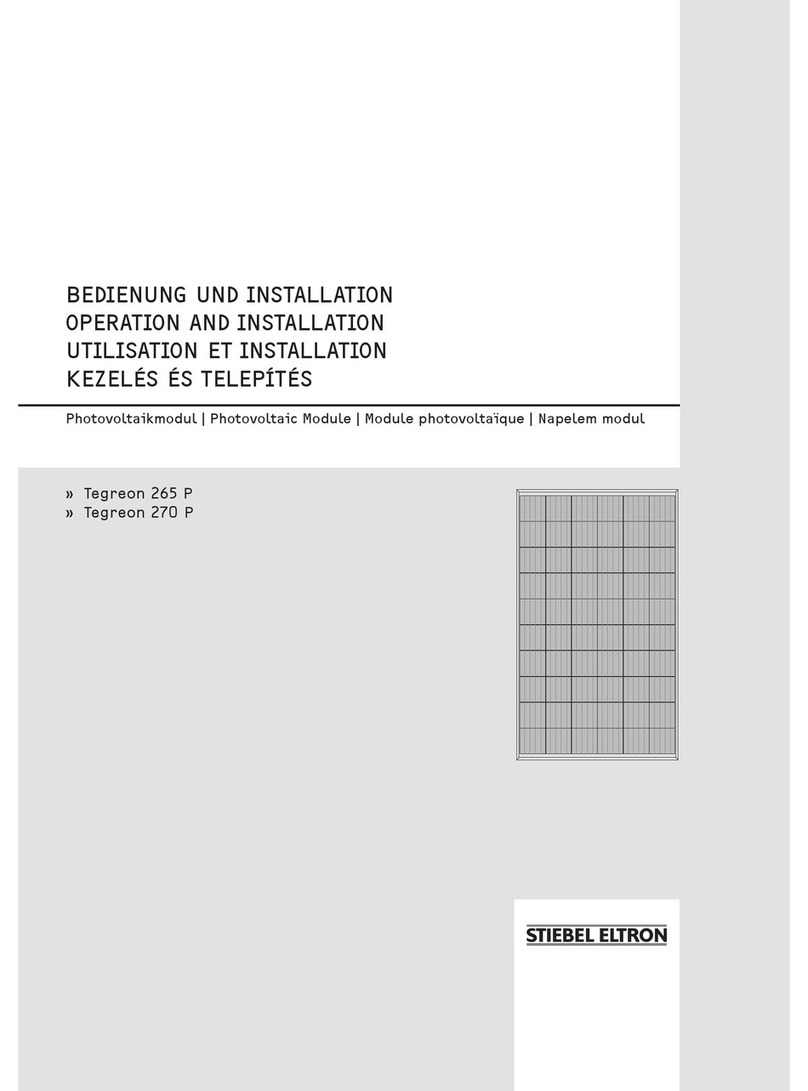
STIEBEL ELTRON
STIEBEL ELTRON Tegreon 265 P Operation and installation
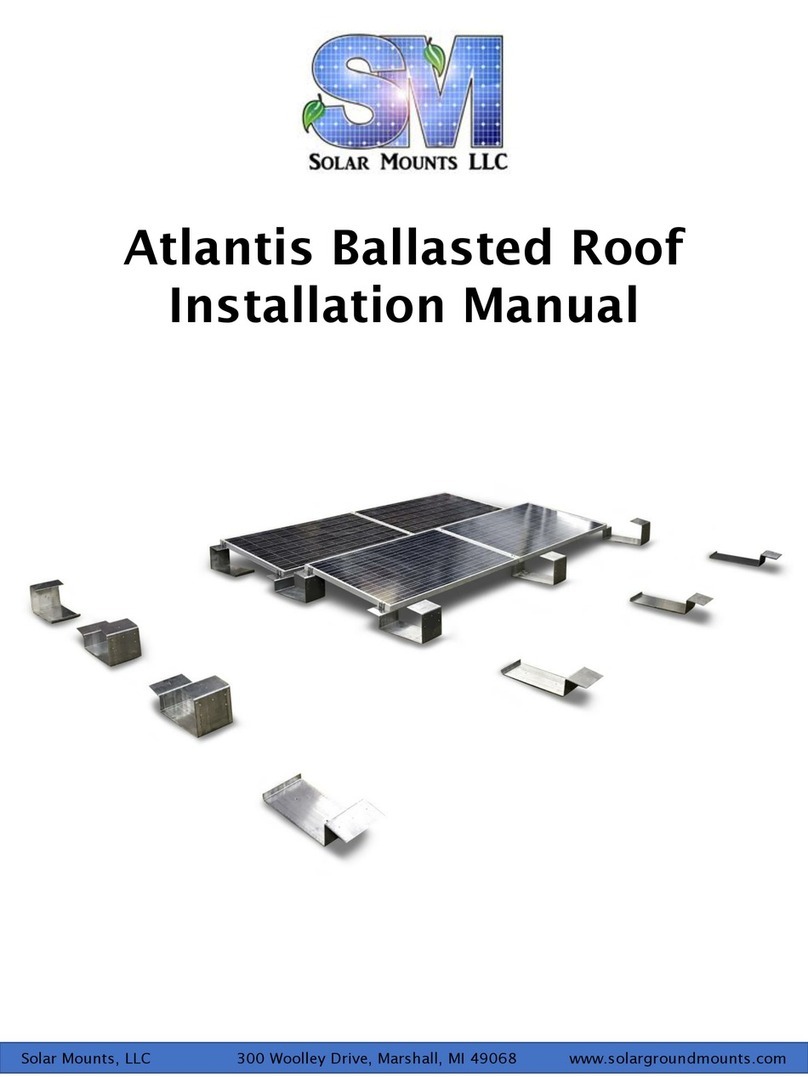
Solar Mounts
Solar Mounts Atlantis installation manual
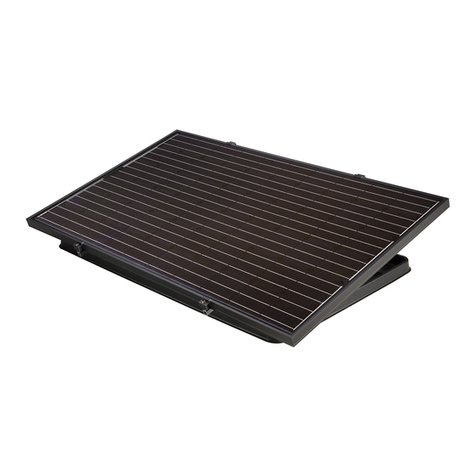
ubbink
ubbink FRS60 installation instructions

Van Der Valk
Van Der Valk ValkBox3 installation manual
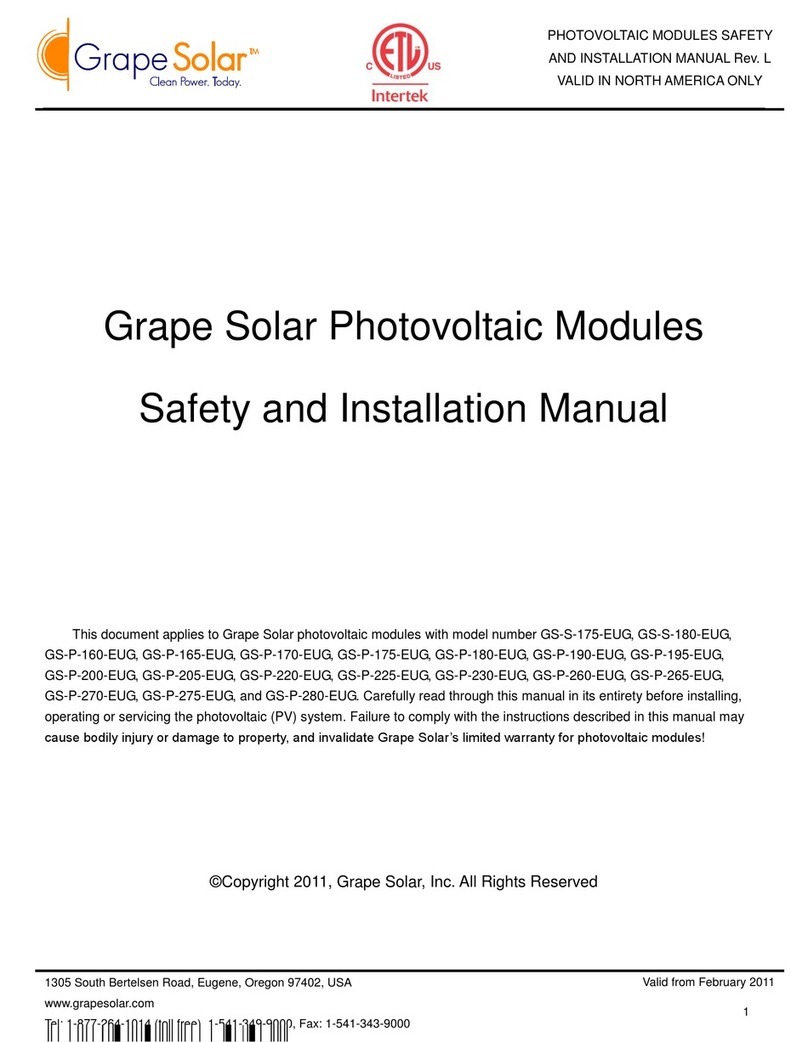
Grape Solar
Grape Solar GS-S-175-EUG Safety and installation manual
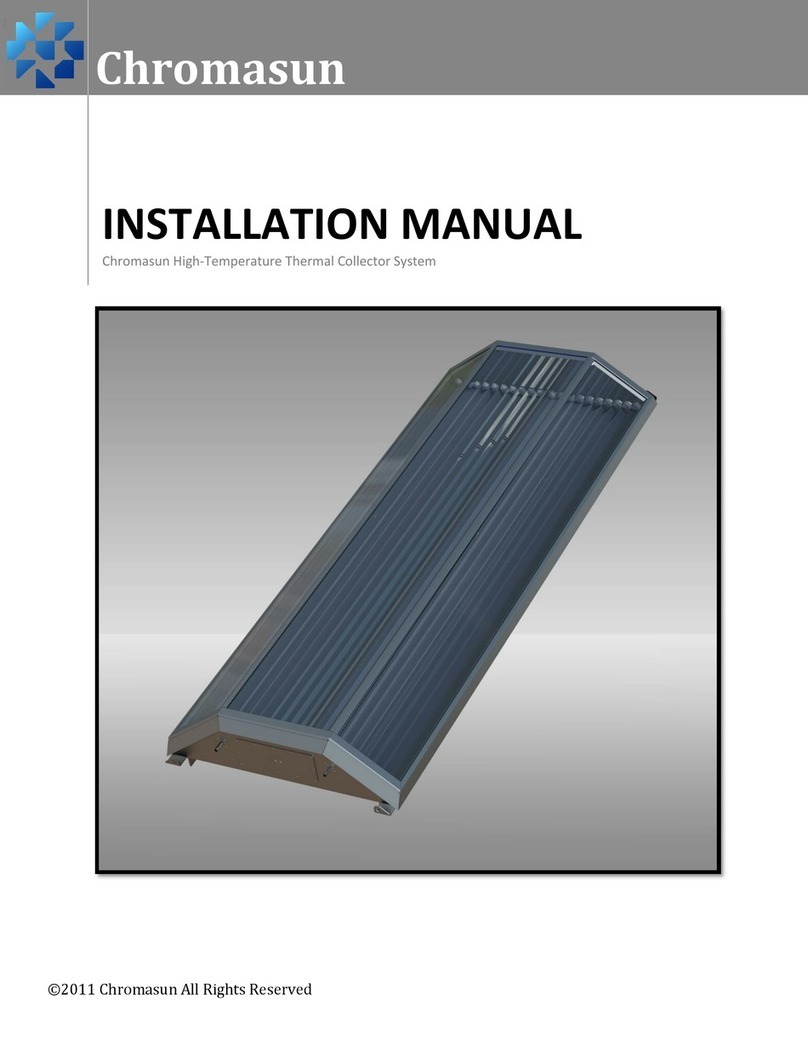
Chromasun
Chromasun High?Temperature Thermal Collector System installation manual
